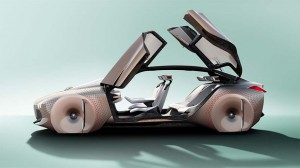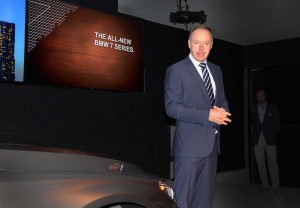
The BMW Vision shows its flexible body panels, forward and rear gullwing doors and living room-like cabin.
While some automakers hope to have their first autonomous vehicles in production by 2020 – and perhaps even sooner – the BMW board member in charge of global sales thinks that is far too optimistic.
The reality is “probably 2025 or beyond,” cautioned BMW veteran Ian Robertson. “The technology will be there before the legislation is there,” Robertson said, during an interview with TheDetroitBureau.com.
The Bavarian automaker, best known for its sporty and high-performance cars and light trucks, has also been a long-time proponent of autonomous vehicles, its senior executives first discussing the concept of self-driving technology before the turn of the millennium.
BMW recently showed off a concept vehicle, the Vision Next 100, designed to both celebrate the company’s centennial and give a hint of where it sees itself going as it enters its second century. The battery-powered Vision concept would allow a motorist to switch between conventional, manual driving and fully autonomous mode.
“Our objective,” BMW Group Design director Adrian van Hooydonk explained, during the show car’s debut earlier this month, “was to develop a future scenario that people would engage with. Technology is going to make significant advances, opening up fantastic new possibilities that will allow us to offer the driver even more assistance for an even more intense driving experience.”
(BMW Vision Next 100 offers look at century to come. For more, Click Here.)

BMW's Ian Robertson isn't as optimistic as his peers when it comes to autonomous vehicles. saying they won't arrive in earnest until 2025 at the earliest.
BMW now says it will launch a production version of the Next 100. It will be called the iNext, explained board member Robertson, who called it a “completely new step” for the automaker. The production model will be added to the carmaker’s battery-based, brand-within-a-brand, BMW i, a line that currently includes the battery-electric i3 city car and the plug-in hybrid i8 sports car.
“We haven’t decided on the powertrain” for the production version of the Vision Next 100, Robertson cautioned, but he stressed that the new model will mark a “big step” for BMW in its push to bring autonomous technology to market. “This will be the big innovation.”
The precise timing of the iNext is also uncertain, but it would not reach market until “after 2020,” the executive said. And it is possible that, at least initially, it would not offer full autonomy.
“A lot of water has to go under the bridge” before that can happen, Robertson cautioned. Especially “in terms of legislation.”
(Click Here for TDB’s first drive in the new BMW 640i xDrive Gran Coupe.)
Robertson isn’t the only one worried about the need to rewrite the rules before autonomous vehicles can come to market. A number of automakers have stressed that regulators around the world will not only have to spell out what is permissible, but also take steps to protect manufacturers against what could become a flood of costly lawsuits.
“We allow humans to make mistakes,” said Robertson, adding that we may be less forgiving whenever an autonomous vehicle crashes.
Proponents frequently claim that self-driving technology will lead to a sharp decline in crashes – 90% of which are the result of human error – but most observers expect there to be at least some collisions involving autonomous vehicles. That risk was underscored when a prototype Google vehicle sideswiped a California commuter bus in February.
Many in the industry have warned that autonomous technology could be slow to come to the litigious United States. But Robertson was a bit more upbeat, noting recent steps taken by Washington safety regulators. At a meeting with Anthony Foxx, the U.S. Secretary of Transportation, late last year, Robertson mentioned that BMW couldn’t test its new self-parking technology because of current American rules. Within eight weeks, the restrictions were lifted.
(To see more about BMW taking a long-forbidden step with the M brand, Click Here.)
“It shows the government is listening,” said Robertson. But whether it will move quickly enough, or far enough, to keep autonomous technology on track is another matter.
